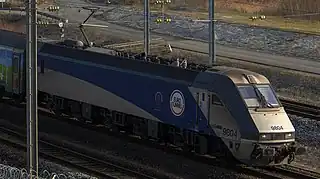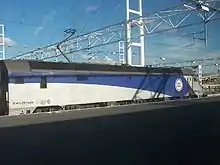Eurotunnel Class 9
The Eurotunnel Class 9 or Class 9000 are six-axle high-power Bo′Bo′Bo′ single-ended electric locomotives built by the Euroshuttle Locomotive Consortium (ESCL) of Brush Traction and ABB. The class was designed for and is used exclusively to haul the LeShuttle road vehicle services through the Channel Tunnel.
| Eurotunnel Class 9 | |||||||||||||||||||||||||||||||
|---|---|---|---|---|---|---|---|---|---|---|---|---|---|---|---|---|---|---|---|---|---|---|---|---|---|---|---|---|---|---|---|
 Locomotive 9804 in 2019 | |||||||||||||||||||||||||||||||
| |||||||||||||||||||||||||||||||
| |||||||||||||||||||||||||||||||
| |||||||||||||||||||||||||||||||
| |||||||||||||||||||||||||||||||
Background and design
Tendering for the locomotive procurement began in 1989. The specification included; a top speed of 160 km/h (100 mph); a terminal-to-terminal travel time of 33 minutes pulling a 2,100-tonne (2,067-long-ton; 2,315-short-ton) train; an axle load limit of 22.5 tonnes (22.1 long tons; 24.8 short tons); an operating temperature range between −10 °C (14 °F) and 45 °C (113 °F);[6] a loading gauge within the UIC 505-1 standard; a minimum curve radius of 100 m (5 chains);[7] be able to start a shuttle train on a 1 in 160 (0.625 %) gradient with one locomotive bogie inoperative (at 0.13 m/s2 (0.43 ft/s2)), and a single locomotive should be able to start the train on the same gradient if the other locomotive failed.[6][7] The operating concession agreement between the tunnel operator and the British and French governments required that there be a locomotive on either end of the train, allowing the reversing or splitting of the train in an emergency.[6]
The design specifications implied a minimum power of 5.6 MW (7,500 hp), and also meant that a four-axle design would not be guaranteed to be able to supply sufficient tractive effort. ESCL proposed a six-axle Bo′Bo′Bo′ locomotive derived from the narrow-gauge EF class locomotives supplied by Brush Traction to the New Zealand Railways Corporation and won the contract with an initial order of 40 in July 1989.[6][1][8]
The main traction electrical system consists of:[note 1] two pantographs (duplicated for redundancy) collecting a 25 kV AC supply which feeds the main transformer, with separate output windings rectified to a DC link (one per bogie) using four quadrant converters. The direct current drives a three-phase inverter, which powers two asynchronous three-phase induction motors.[4][9] There are two additional output windings on the transformer for the locomotive's auxiliaries and to supply power to the train vehicles.[4]
The bogies were a fabricated steel design, with coil spring primary suspension. The traction motors and gearboxes (one per axle) were mounted to the bogie frame and connected to the wheels by a flexibly coupled quill drive. Traction links were connected to the bogie frame at a height of 200 mm (7.87 in) above rail. The locomotive superstructure is supported on coil springs on a central swing bolster, and the centre bogie allows 200 mm (7.87 in) of lateral movement to negotiate small-radius curves.[1] Yaw dampers are also fitted.[1]
The locomotive superstructure is a stressed-skin monocoque design.[1] Both the bogies and superstructures were fabricated by Qualter, Hall and Company of Barnsley.[10]
The driver's cab and exterior design of the locomotives was undertaken by DCA Design.[11] Side windows in the locomotive cab are omitted to prevent 'segment flicker' caused by fast running in the tunnel, a potential distraction and cause of operator drowsiness.[12] The operator's cabin is air conditioned and pressurised for comfort.[6] The locomotive uses in-cab TVM 430 signalling.[13] The driving cab also incorporates train manager's facilities, including safety systems such as CCTV, alarms and communication links. There is a second driving position for shunting at the rear of the locomotive.[6][note 2]
Testing and operations
The initial order for 40 units was reduced to 38,[1] numbered 9001 to 9038.[13] The first locomotive was completed in 1992, and two units (9003 and 9004) were tested at the Velim test track in the Czech Republic.[13] Locomotive 9004 started its required 50,000-kilometre endurance test at Velim on 17 August 1993 and finished it on 23 September 1993.[14]
The locomotives are maintained at the Eurotunnel depot located just beside Eurotunnel Calais Terminal at Coquelles near Calais, France.[13][note 3]
The formal opening took place on 6 May 1994 with Queen Elizabeth II and François Mitterrand travelling on a shuttle through the tunnel.[13]
The 1996 Channel Tunnel fire damaged locomotive 9030 beyond repair.
Later subclasses
9100 subseries
In 1997, Eurotunnel ordered five more locomotives and in 1998 the order was increased to a total of 14. This second batch of locomotives also had small improvements compared to the originals, including IGBT-based traction inverters instead of GTO-based and one inverter per motor instead of one per bogie.[2]
This second batch of locomotives is numbered in the 9100 series (9101 to 9113) except for one locomotive, 9040 which was purchased as a replacement for 9030, the locomotive destroyed in the 1996 fire.[13]
9700 subseries
In 1999, Eurotunnel ordered seven locomotives with an increased power of 7 MW (9,387 hp). This third batch of locomotives was delivered between 2001 and 2003, and is numbered in the 9700 series (9701 to 9707).[15][13] The higher power output allowed an increase in the length and weight of cargo shuttle trains.[13]
9800 subseries
.jpg.webp)

Since 2000, Eurotunnel has been slowly rebuilding the older 9000 and 9100 series locomotives from 5.6 to 7 MW (7,500 to 9,400 hp), replacing the main transformer, traction converters and motors.[5] These rebuilt locomotives are numbered in the 9800 series.
By late 2017 of the 57 locomotives, 45 of them had been upgraded to the 7 MW (9,400 hp) standard, while the remaining 12 had the original 5.6 MW (7,500 hp) power.[16]
| Number range | Built | Power | Notes |
|---|---|---|---|
| 9001–9038 | 1992–1994 | 5.6 MW (7,500 hp) | 9030 withdrawn due to fire damage |
| 9040 | 1998 | Built to replace fire-damaged locomotive 9030 | |
| 9101–9113 | 1998–2001 | Dedicated to freight shuttles | |
| 9701–9707 | 2001–2002 | 7 MW (9,400 hp) | |
| 9801– | Rebuilt 2004-2012 | Rebuilt from 5.6 MW (7,500 hp) machines |
Names
After introduction the locomotives were named after opera singers. In 1997 four units were named Jungfraujoch, Lötschberg, Gotthard and Furkatunnel, after Swiss rail tunnels.[17]
| Number | Name |
|---|---|
| 9005 | Jessye Norman |
| 9007 | Dame Joan Sutherland |
| 9011 | José van Dam |
| 9013 | Maria Callas |
| 9015 | Lötschberg 1913 |
| 9018 | Wilhelmenia Fernandez |
| 9022 | Dame Janet Baker |
| 9024 | Gotthard 1882 |
| 9026 | Furkatunnel 1982 |
| 9029 | Thomas Allen |
| 9033 | Montserrat Caballé |
| 9036 | Alain Fondary |
| 9037 | Gabriel Bacquier |
| 9801 | Lesley Garrett |
| 9802 | Stuart Burrows |
| 9803 | Benjamin Luxon |
| 9804 | Victoria de los Ángeles |
| 9806 | Régine Crespin |
| 9808 | Elisabeth Söderström |
| 9809 | François Pollet |
| 9810 | Jean-Philippe Courtois |
| 9812 | Luciano Pavarotti |
| 9814 | Lucia Popp |
| 9816 | Willard White |
| 9819 | Maria Ewing |
| 9820 | Nicolai Ghiaurov |
| 9821 | Teresa Berganza |
| 9823 | Dame Elisabeth Schwarzkopf |
| 9825 | Jungfraujoch 1912 |
| 9827 | Barbara Hendricks |
| 9828 | Kiri Te Kanawa |
| 9831 | Plácido Domingo |
| 9832 | Renata Tebaldi |
| 9834 | Mirella Freni |
| 9835 | Nicolai Gedda |
| 9838 | Hildegard Behrens |
Notes
- Details from Brush Traction in 2011, some figures assumed correct only for rebuilt locomotives.[4]
- The second driving position was omitted on later builds.[13]
- 50.922664°N 1.822448°E Coquelles Eurotunnel depot
References
- Ford 1995, pp. 176–178.
- Allenbach et al. 2008, fiche 8.2.15
- Marsden & Fenn 2001, p. 143.
- "Shuttle Locomotives". Loughborough: Brush Traction Group. Archived from the original on 5 October 2011.
- "Adapting the locomotives and Truck Shuttles to growth of the market". Paris: Groupe Eurotunnel. Archived from the original on 13 June 2011.
- Driver 1995, pp. 9–12.
- Driver 1996, p. 72.
- Semmens & Machefest-Tassin 1994, pp. 16–18.
- Ford 1995, p. 180.
- "Channel Tunnel Locomotive Superstructures". Barnsley: Qualter, Hall and Company. Archived from the original on 6 February 2012.
- "Channel tunnel shuttle and locomotive" (PDF). Warwick: DCA Design International. 2006. Archived from the original (PDF) on 20 July 2011.
- Donovan 2003, p. 49.
- Glasspool, D. "Eurotunnel Tri-Bo Shuttle Locomotives". Kent Rail. Retrieved 6 June 2023.
- Hamlen, J., ed. (October 1993). "Czech Checks". The Link. No. 47. Folkestone: Translink Joint Venture. pp. 10–11.
- Marsden 2007, p. 88.
- "Rolling Stock". Paris: Groupe Eurotunnel. Archived from the original on 28 September 2017.
- Marsden & Ford 1998, pp. 326–328, ch. EuroTunnel 'Shuttle' Locos.
- Haydock 2020, p. 33.
Sources
- Allenbach, J.-M.; Chapas, P.; Comte, M.; Kaller, R. (2008). "Exemples de Véhicules Réalisés". Traction électrique (in French) (2nd ed.). Lausanne: Presses polytechniques et universitaires romandes. ISBN 978-2-88074-674-2. OCLC 288977887.
- Donovan, S. (2003). The Channel Tunnel. Great Building Feats. Minneapolis: Lerner Publications. ISBN 978-0-8225-4692-4. OCLC 50520477. OL 9805145M.
- Driver, B. (1995). "The Shuttle Trains – Design and Development". Proceedings of the Institution of Civil Engineers - Civil Engineering. London: Thomas Telford for the Institution of Civil Engineers. 108 (6, pt. 4): 3–12. doi:10.1680/icien.1995.28044. ISBN 978-0-7277-2024-5. ISSN 0965-089X.
- Driver, B. (1996). "Shuttles". In Penny, C. (ed.). Channel Tunnel transport system: proceedings of the conference organized by the Institution of Civil Engineers and held in London on 4–5 October 1994. London: Thomas Telford. pp. 57–75. doi:10.1680/ctts.25158. ISBN 978-0-7277-2515-8. OCLC 35285648.
- Ford, R. (1995). "Locomotives". In Kirkland, C. J. (ed.). Engineering the Channel Tunnel. London: E & FN Spon. pp. 175–190. ISBN 978-0-419-17920-7. OCLC 33062417.
- Haydock, D. (2020). Channel Tunnel: 25 Years of Experience. Sheffield: Platform 5 Publishing. ISBN 978-1-909431-77-5. OCLC 1162884345.
- Marsden, C. J.; Ford, D. (1998). The Encyclopaedia of Modern Traction Names. Bournemouth: Channel AV Publishing. ISBN 978-1-901419-02-3. OCLC 862626333.
- Marsden, C. J.; Fenn, G. B. (2001). British Rail Main Line Electric Locomotives (2nd ed.). Hersham: Oxford Publishing Company. ISBN 978-0-86093-559-9. OCLC 48532553.
- Marsden, C. J. (2007). Traction Recognition. Hersham: Ian Allan Publishing. ISBN 978-0-7110-3277-4. OCLC 230804946. OL 16902750M.
- Semmens, P. W. B.; Machefest-Tassin, Y. (1994). Channel Tunnel Trains: Channel Tunnel Rolling Stock and the Eurotunnel System. Folkestone: Channel Tunnel Group. ISBN 978-1-872009-33-9. OCLC 37156065.
Literature
- Julien, L.; Machefert-Tassin, Y. (1994). "Les locomotives électriques des navettes" [The electric locomotives for the Eurotunnel shuttles]. Revue générale des Chemins de fer (in French). 1994 (2): 41–69. ISSN 0035-3183. INIST:4182585.
- Treacy, R. (1994). "The 'Le Shuttle' locomotives for the Channel Tunnel". ABB Review. 94 (4): 4–15. ISSN 1013-3119.
- Schneider, H.; Vitins, J. (1995). "MICAS-S2 distributed traction control for motive power units" (PDF). ABB Review. 1995 (5): 11–20. ISSN 1013-3119.
- May, C. C.; Phillips, C. R. G. (1989). "Channel Tunnel Shuttle locomotives, an overview of the design process". International Conference on Main Line Railway Electrification, 25–28 September 1989. London: the Institution of Electrical Engineers. pp. 408–412. ISBN 978-0-85296-384-5. OCLC 79818112.
Further reading
- "Brush wins Shuttle order". Rail. No. 102. EMAP National Publications. 10–23 August 1989. p. 5. ISSN 0953-4563. OCLC 49953699.
- Hughes, Barrie (June 1996). "Eurotunnel orders new shuttles". Rail Express. No. 1. Foursight Publications Ltd. p. 9. ISSN 1362-234X. OCLC 498432844.
- "Shuttle locomotives under construction". Rail. No. 327. EMAP Apex Publications. 25 March – 7 April 1998. p. 59. ISSN 0953-4563. OCLC 49953699.
- "Eurotunnel accepts its first freight-only Le Shuttle locomotives". Rail. No. 331. EMAP Apex Publications. 20 May – 2 June 1998. p. 20. ISSN 0953-4563. OCLC 49953699.
External links
![]() Media related to Eurotunnel Class 9 at Wikimedia Commons
Media related to Eurotunnel Class 9 at Wikimedia Commons